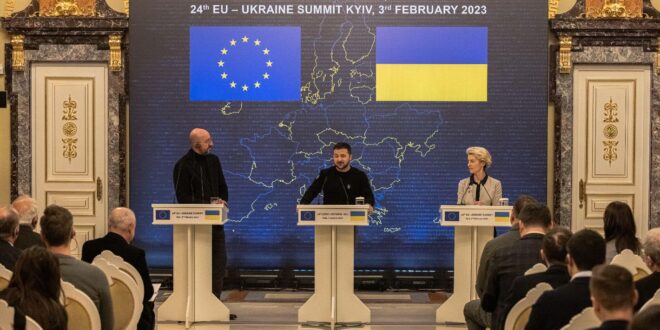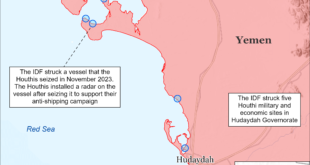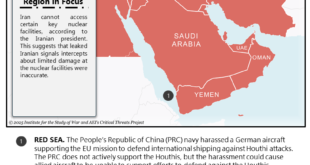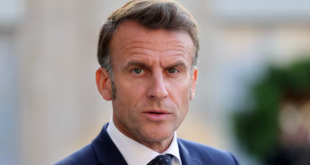Summary:
The prospect of further enlargement presents the EU with multiple institutional, policy, and financial dilemmas. The successful integration of Ukraine and other candidate countries will require pragmatism, reforms, and transitional arrangements.
The EU’s 2022 decision to grant candidate country status to Moldova and Ukraine suddenly revived the debate on the union’s capacity to integrate further member states, a debate that had been dormant for more than fifteen years. Discussions now focus in particular on the institutional reforms necessary to accommodate several new Western Balkan and Eastern European member states, on the challenge of bringing a large and war-torn country such as Ukraine—which also happens to be an agricultural powerhouse—into the EU, and on the financial implications of future enlargement.
While the problems look formidable, enlargement will take considerable time, and the EU has developed instruments of flexibility and differentiation that should make the task easier. It will be important to handle discussions of the EU’s absorption capacity in a responsible manner, so that blockages are avoided and the union can once again rise to the challenge of strengthening European stability by including new partners in EU integration.
Widening and Deepening
Concerns that the accession of more countries would threaten the EU’s functioning have been an important feature of enlargement discussions since the very beginning. When then French president Charles de Gaulle vetoed the UK’s accession in the 1960s, he argued that the specificities of the country’s economy could not be accommodated within the existing European Economic Community—although concerns about the UK’s strong ties with the United States were probably his real motivation. In 1983, the Portuguese and Spanish accessions were delayed by worries about the financing of the Common Agricultural Policy (CAP). At the beginning of the 1990s, the European Commission postponed accession talks with Austria, Finland, and Sweden until the legislation to establish the European single market was completed. The European Parliament regularly passed resolutions before new accessions calling for institutional reforms and more powers for itself to safeguard the effectiveness of EU decisionmaking and strengthen European democracy.
In 1993, the European Council adopted the Copenhagen criteria—the rules that define whether a country can join the EU—and thereby elevated the union’s absorption capacity to a key principle of the enlargement process. The relevant sentence reads: “The Union’s capacity to absorb new members, while maintaining the momentum of European integration, is also an important consideration in the general interest of both the Union and the candidate countries.”
The Copenhagen criteria were developed with a view to achieving the most ambitious enlargement project ever undertaken: the accessions of ten Central and Eastern European countries, Cyprus, and Malta. Many national governments as well as the European Parliament and the European Commission felt that an institutional framework originally designed for six countries and already stretched to include fifteen would have to be significantly adjusted to make room for twelve additional countries.
A first attempt to negotiate the necessary reforms resulted in some tortuous compromises on voting weights and the compositions of the parliament and the commission. But the Nice Treaty, signed in 2001, was widely criticized for its lack of ambition and was quickly followed by another major reform effort, which aimed for a constitutional treaty for the EU.
The Eastern and Southern European candidates did not, however, have to wait for the completion of this project. Ten of them joined in 2004, and Bulgaria and Romania were allowed to accede in 2007, even though the constitutional treaty had in the meantime been rejected in referenda in France and the Netherlands.
After most of the proposed constitution’s substantive and institutional provisions had been salvaged in the 2007 Lisbon Treaty, the debate over widening and deepening soon lost momentum. EU enlargement to the Western Balkans and Turkey was stagnating—only Croatia joined in 2013—and the debacle of the constitutional treaty made governments wary of launching yet another treaty reform. For the following fifteen years, EU leaders were fully occupied managing a series of deep crises, ranging from turmoil in the eurozone to Russian aggression against Ukraine.
However, the EU’s June 2022 granting of candidate status to Moldova and Ukraine has revived the debate. EU leaders understand the geopolitical necessity and urgency of anchoring Ukraine firmly in the West, but they are also aware that in view of the country’s security situation and economic and structural deficits, Ukraine’s membership would pose greater challenges than any previous EU enlargement.
Three conclusions can be drawn from this short summary of the history of widening and deepening in the EU.
First, enlargement never comes about easily or smoothly. Typically, the commission, which runs the process, takes a positive approach toward future accessions. Governments are usually divided. Some support bringing in new countries, but others believe they have little to gain in the process. The skeptics fear that their particular interests will receive less attention in the future. They worry about the loss of cohesion of an expanded union and about the reduction of their voting weight and influence. Some existing member states may also have unresolved bilateral issues with individual candidate countries. Enlargement therefore inevitably involves a good deal of internal bargaining. Some of this takes place under the guise of ensuring the EU’s absorption capacity.
The fact that despite these obstacles, the EU has gone through seven rounds of enlargement was mainly due to geopolitical necessity. Enlargement was driven in the early phases by the need to consolidate Western Europe in the context of the Cold War and later by the necessity of stabilizing and transforming the liberated parts of the former Soviet empire. Today, the renewed Russian threat and the overall rise of global power politics have revived interest in bringing in Western Balkan and Eastern European countries.
Second, absorption capacity sounds like a technical term but is in reality a deeply political concept. This is not to say that there are not genuine institutional, policy-based, or financial constraints that have to be overcome to integrate new member states successfully. But in the actual politics of enlargement, these are submerged under layers of the particular preferences and priorities of member states and institutions. Governments have used absorption capacity as an argument to delay accessions they simply do not favor, obtain concessions to protect their national interests, or advance policy objectives they consider necessary for the EU’s further development.
Third, widening and deepening are two processes that have fundamentally shaped the EU’s development over the decades. But there is no overarching concept or master plan that informs the EU’s evolution. The most important integration projects—such as the internal market, the euro, the passport-free Schengen Area, or the Common Foreign and Security Policy—had little to do with enlargement. However, enlargement at times has significantly influenced the direction of EU policies, as new member states brought their own priorities to the table. The dynamic development of the EU’s cohesion policy following the accessions of Portugal and Spain is a case in point.
Major institutional reforms—including direct elections to the European Parliament, the setting up of the European Council, or the introduction of co-decision, the EU’s main legislative procedure—were also primarily driven by internal developments. Expanding the use of majority voting, as opposed to decisionmaking by unanimity, was much discussed in the context of enlargements, but the real breakthroughs served integration projects such as the internal market or cooperation on justice and home affairs. The historical record thus does not show any particular pattern or sequencing. In moving forward in the direction of widening or deepening, the EU seems to respond to the dominant external or internal challenges of the moment. This is unlikely to change in the future.
The Components of Absorption Capacity
Following an invitation by the European Council, the commission in 2006 delivered a special report on absorption capacity—now renamed integration capacity—which formed an annex to a broader enlargement strategy paper. In this text, the commission took a cautious approach, obviously aiming to avoid creating additional obstacles for the ongoing enlargement process. Integration capacity was defined as a “functional concept” about “whether the EU can take in new members at a given moment or in a given period, without jeopardizing the political and policy objectives established by the Treaties.”
The commission identified the components of integration capacity. First, the EU institutions and decisionmaking procedures must remain effective and accountable. Second, the union needs to be in a position to continue developing and implementing common policies in all areas. And third, the EU must be able to continue financing its policies in a sustainable manner.
On all three issues, the commission avoided going into the substance of what steps would be necessary or desirable before further enlargements could take place. Instead, it reassured member states that it would carefully assess these issues and report regularly on them throughout the enlargement process.
Almost as an afterthought, the commission added a fourth element: sufficient public support for enlargement in the member states. As any EU accession treaty has to be ratified by twenty-seven national parliaments and, in some cases, approved through a referendum, public opinion is certainly a key factor for a successful enlargement. Here the commission attributed the primary responsibility to national governments, which it believes need to make the case for enlargement more convincingly. But it promised to contribute to the process by rigorously enforcing the conditions on aspiring members during the accession talks and through better communication.
The European Council endorsed the strategy in December 2006 and thereby laid the official debate on the issue to rest—until it was suddenly awakened in summer 2022.
Absorption Capacity in the Current Context
The Copenhagen criteria first identified the conditions that candidate countries must fulfill for accession and then added absorption capacity as a condition that the EU must fulfill. But these two dimensions cannot be neatly separated. The EU’s capacity to integrate any country crucially depends on the qualities of the respective candidate.
In the 2000s, Turkey was perceived as the biggest integration challenge—and possibly an insurmountable one—but the country’s accession prospects have since receded. Today, Ukraine stands at the center of the debate; the six Western Balkan countries, along with Georgia and Moldova, are considered a challenge more because of their number than because of their individual characteristics.
Thematically, too, the debate has evolved. Military security played practically no role in earlier enlargements, but in view of Russian President Vladimir Putin’s aggressive policies, the EU’s capacity to contribute to the security of Georgia, Moldova, and Ukraine will be a key concern for any future eastern enlargement. Given the democratic backsliding and rule-of-law deficits experienced in some Central European countries, the rule of law will also have to receive greater attention than before. Several governments will insist on more effective instruments to address such problems before new countries can join the EU.
Despite these new elements, the major components of integration capacity identified by the commission in 2006—institutions, policies, and financing—remain broadly relevant today.
Institutions
The debate on the EU institutions will focus mostly on the concern that adding more countries to the union’s already cumbersome machinery could result in more vetoes, slow down decisionmaking, and generally reduce the EU’s effectiveness. Currently, many governments believe that any institutional reform needs to remain within the framework of the Lisbon Treaty. There is little appetite for launching a new heavy and complex process aimed at treaty change. This is not necessarily the last word on this issue, however. In the past, institutional provisions have often been included in accession treaties, which have the same normative force as the EU’s core treaty.
But for the time being, attention is focused primarily on two issues, on which the core treaty already includes mechanisms that allow the union to move forward on the basis of a unanimous decision by the European Council: more majority voting in the Council of Ministers and a smaller commission. Both reforms make eminent sense, but they remain controversial. Some member states continue to believe that they need a veto over decisions in the council to protect their national interests, and especially the smaller states are reluctant to relinquish their right to nominate a member of the commission. The pro-EU governments that favor such reforms also face a dilemma, because they are normally the ones most open to enlargement. Thus, their leverage is limited, and consequently, the progress achieved during similar debates in the context of earlier enlargements has been modest. Today, the prospect is not much brighter.
It may be some comfort, however, that studies have shown that the EU’s massive increase in size following the so-called Big Bang enlargements in 2004 and 2007 has not significantly hampered the effectiveness of EU decisionmaking. In the last few years of permanent crisis management, the EU has at times shown a remarkable capacity to act, even in areas that require unanimity, and by concentrating power at the top, the commission has been able—despite its large size—to display impressive leadership.
Recent experience seems to indicate that institutional arrangements are just one of the factors that determine the EU’s effectiveness—and maybe not the most important one. Still, there is a clear difference between twenty-seven members and up to thirty-six. Governments and the commission therefore need to strike the right balance in undertaking genuine efforts to improve the functioning of the institutions while avoiding overambitious schemes that would run the enlargement process into a wall.
Another aspect of the institutional debate is about power and influence. The prospect of enlargement always triggers calculations on the consequences for promoting and protecting national interests. How will the balance between trade liberals and protectionists change? What about the relative weight of big and small countries? Will there still be a blocking minority for Mediterranean agriculture? When it comes to the new eastern candidates, another question arises: To what extent will there be a power shift toward Eastern Europe?
A preliminary analysis by political scientist Nicolai von Ondarza has shown that the impact of the envisaged Eastern European and Western Balkan enlargements on the distribution of voting power will be relatively modest. All these countries together have a smaller population than the UK. Even if they all voted together—an extremely unlikely scenario—they would not have a blocking minority and would have to look for additional partners. Enlargement to these countries would certainly involve a shift toward Eastern Europe, but it would likely not be significant enough to change the EU’s overall constellation of power.
Policies and Financing
In 2006, the commission identified the EU’s ability “to continue developing and implementing common policies in all areas” as an important part of the union’s integration capacity. That ability can be best assured by the strict enforcement of conditionality in the accession talks. Gradually phasing in policies in particular sectors ahead of accession would smooth the process for both candidates and member states.
On the future development of policies, there could be a growing need to resort to differentiated integration. A union of up to thirty-six members will necessarily be more heterogeneous. Not every member state will be willing and able to move forward at the same pace in all fields. The EU’s core treaty already contains several provisions that set out the conditions for a group of member states to embark on closer integration in various sectors. These mechanisms have rarely been used in the past but could prove valuable following further accessions.
Extending the EU’s existing policies to Ukraine looks particularly challenging. The most obvious example is the CAP. If the current system of per hectare payments to farmers continued and the EU remained a common agricultural market, Ukraine’s accession would overwhelm the CAP budget, and many farms in the existing member states would no longer be competitive. Grain production is highly concentrated in Ukraine, with the ten biggest companies controlling more than 70 percent of the market. The average farm size in Ukraine is 1,000 hectares (2,470 acres), as opposed to 16 hectares (40 acres) in the EU. If Ukraine joined the CAP, giant Ukrainian firms would receive tens of millions of euros in subsidies, and the EU would be swamped with cheap Ukrainian produce.
The EU received a stark warning about these risks after it lifted trade barriers for Ukrainian agricultural produce following the Russian disruption of Ukrainian grain exports. In the face of massive protests by farmers, Hungary, Poland, and Slovakia in April 2023 imposed unilateral bans on imports of Ukrainian grain. In response to massive pressure from these countries, the EU had to impose restrictions on imports of several products.
The EU’s cohesion policy is another case in point. If Ukraine were to join the EU under the current rules, a large part of the policy’s funding would go to a country whose per capita GDP is currently less than 10 percent of that of the EU. Several countries that are net recipients from the policy would become net payers, which would no doubt cause major friction.
It is highly unlikely that the EU would be willing in the near term to expand its financing to such an extent that Ukraine could be integrated into the CAP and the cohesion policy without significant losses for existing member states. It is even less probable that the EU would agree on drastic reforms of these policies to make them compatible with Ukraine’s situation. In either case, public support in the EU for Ukraine’s accession would crash and the process would be effectively blocked.
In the longer term, however, it seems likely that both the CAP and the cohesion policy will have to undergo major changes, not least in adapting to the requirements of the climate transition. Eventually, the incompatibility between the EU’s current policies and Ukraine’s structural specificities might look less forbidding than it does today. Also, as with other enlargements, there will be scope for transitional arrangements, so that some of the issues could be resolved later.
There is general agreement that Ukraine will have to receive massive EU financial support for its postwar reconstruction. It is also understood that this support should be offered in a way that enables the reforms necessary for EU accession. It would only be fair for Ukraine to accept as a corollary that it will not be fully integrated into the CAP or the cohesion policy for a considerable time.
Even if such a trade-off could reduce the burden drastically, there can be no doubt that enlargement will have significant financial implications. And this impact will come on top of other challenges, such as investments in the climate transition, transnational infrastructure, and industrial transformation. Many experts believe that considerable additional funding will be needed, including new so-called own resources—various types of EU taxes. The next multiyear budget, which runs from 2028 to 2035, will thus have a key role in preparing the EU for enlargement.
Conclusion
The EU’s enlargement challenge today looks highly asymmetric: as far as the Western Balkan countries are concerned, the main constraint appears to be not so much a lack of integration capacity as insufficient integration willingness on both sides. Progress on reforms in these countries has been painfully slow, and confidence in a future in the EU has gradually faded. The EU, for its part, has not displayed the commitment and level of engagement necessary to reverse this negative dynamic.
As for Ukraine, the EU will have genuine problems in integrating a country that is so big and so different from the present members. However, depending on the evolution of the war, there may well be a geopolitical imperative to move forward rapidly. If that is the case, the EU and Ukraine will need to develop long transition schemes and, in some respects, tailor-made solutions. Financial support for Ukraine certainly requires a separate regime from the union’s normal funding instruments for the foreseeable future.
Moldova and, potentially, Georgia fall between the Western Balkans and Ukraine. As small countries, they would be easier to integrate than Ukraine, although they too face serious governance and economic challenges. Their exposure to the Russian threat might motivate the EU to approach their accession perspectives similarly to Ukraine’s.
It will be important to handle the forthcoming debate on the EU’s integration capacity in a pragmatic manner. Institutional adaptations to make EU decisionmaking more effective are desirable, but overly ambitious demands could quickly result in blockages. Also, the policy-related and financial difficulties of integrating Ukraine should not be overdramatized. Realistically, the accessions of the Western Balkan and Eastern European candidates will take several years, possibly more than a decade, and will happen in stages. Incremental reforms from both the acceding countries and the EU could greatly reduce the challenge. Employing models of differentiated integration could also ease the burden considerably.
A good outcome of these discussions would be for the next commission president to do what could be called a “reverse Juncker”: former European Commission president Jean-Claude Juncker stated shortly after his election in June 2014 that no enlargement would take place during his commission’s term in office. Factually, he was merely stating the obvious, as no country was ready to accede during that time. As a political signal, it was felt as a cold shower by the countries aiming to join the EU. It would be very positive signal if a future president could announce that during his or her term, the EU will develop the necessary integration capacity to welcome the first candidate countries that have fulfilled the membership criteria.
 Eurasia Press & News
Eurasia Press & News



